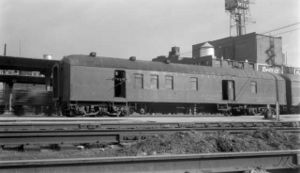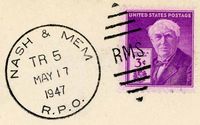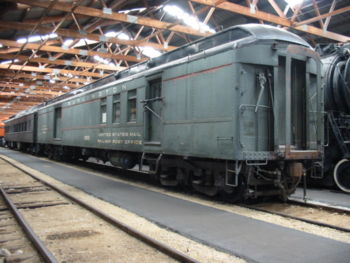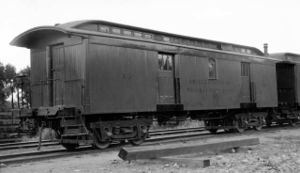Railway post office
2007 Schools Wikipedia Selection. Related subjects: Railway transport
In the United States a railway post office, commonly abbreviated as RPO, was a railroad car that was normally operated in passenger service as a means to sort mail en route, in order to speed delivery. The RPO was staffed by highly trained Railway Mail Service postal clerks, and was off-limits to the passengers on the train.
Many American railroads (the Atchison, Topeka and Santa Fe Railway being just one) earned substantial revenues through contracts with the Post Office to carry mail aboard high-speed passenger trains. In fact, a number of companies maintained passenger routes where the financial losses from moving people were more than offset by transporting the mail.
History
The first-ever sorting of mail en route occurred in the United Kingdom with the introduction of the Travelling Post Office in 1838. In the United States it was introduced on July 28, 1862 using converted baggage cars on the Hannibal and St. Joseph Railroad (which also delivered the first letter to the Pony Express). Purpose built RPO cars entered service on this line a few weeks after the service was initiated. Its purpose was to separate mail for connection with a westbound stage departing soon after the train's arrival at St. Joseph. This service lasted approximately one year. The first permanent Railway Post Office route was established on August 28, 1864 between Chicago, Illinois, and Clinton, Iowa. This service is distinguished from the 1862 operation because mail was sorted to and received from each post office along the route, as well as major post offices beyond the route's end-points.
By the 1880s, railway post office routes were operating on the vast majority of passenger trains in the United States. A complex network of interconnected routes allowed mail to be transported and delivered in a remarkably short time. Railway mail clerks were subjected to stringent training and ongoing testing of details regarding their handling of the mail. On a given RPO route, each clerk was expected to know not only the post offices and rail junctions along the route, but also specific local delivery details within each of the larger cities served by the route. Periodic testing demanded both accuracy and speed in sorting mail, and a clerk scoring only 96% accuracy would likely receive a warning from the Railway Mail Service division superintendent.
In the United States, RPO cars (also known as mail cars or postal cars) were equipped and staffed to handle most back-end postal processing functions. First class mail, magazines and newspapers were all sorted, cancelled when necessary, and dispatched to post offices in towns along the route. Registered mail was also handled, and the foreman in charge was required to carry a regulation pistol while on duty to discourage theft of the mail.
An interesting feature of most RPO cars was a hook that could be used to snatch a leather or canvas pouch of outgoing mail hanging on a track-side mail crane at smaller towns where the train did not stop. With the train often operating at 70 miles per hour or faster, a postal clerk would have a pouch of mail ready to be dispatched as the train passed the station. In a coordinated movement, the catcher arm was swung out to catch the hanging mail pouch while the clerk stood in the open doorway. As the inbound pouch slammed into the catcher arm, the clerk kicked the outbound mail pouch out of the car, making certain to kick it far enough that it was not sucked back under the speeding train. An employee of the local post office would retrieve the pouch and deliver it to the post office.

Most RPO cars had a mail slot on the side of the car, so that mail could actually be deposited in the car, much like using the corner mail box, while the train was stopped at a station. Those desiring the fastest delivery would bring their letters to the train station for dispatch on the RPO, knowing that overnight delivery would be virtually assured. The mail handled in this manner received a cancellation just as if it had been mailed at a local post office, with the cancel giving the train number, endpoint cities of the RPO route, the date, and RMS Railway Mail Service or PTS Postal Transportation Service between the killer bars. Collecting such cancellations is a pastime of many philatelists and postal history researchers. The Railway Mail Service organization within the Post Office Department existed between 1864 and September 30, 1948. It was renamed the Postal Transportation Service on October 1, 1948 and existed until 1960. After 1960, the management of railway post office routes as well as Highway Post Office routes, Air Mail Facility, Terminal Railway Post Office, and Transfer Office, were shifted to the Bureau of Transportation.

After 1948, the railway post office network began its decline although it remained principal intercity mail transportation and distribution function within the Post Office Department. There were 794 RPO lines operating over 161,000 miles of railroad in that year. Only 262 RPO routes were still operating by January 1, 1962. In 1942, the United States Postal Service (USPS) began experimenting with a highway version of the RPO to serve the same purposes along routes where passenger train service was not available. These highway post office (HPO) vehicles were initially intended to supplement RPO service, but in the 1950s and 1960s, HPO's often replaced railway post office cars after passenger train service was discontinued. When the post office made a controversial policy change to process mail in large regional "sectional centers," the remaining railway post office routes along with all highway post office routes were phased out of service. In September of 1967 the USPS cancelled all "rail by mail" contracts, electing to move all First Class mail via air and other classes by road (truck) transport. This announcement had a devastating effect on passenger train revenues; the Santa Fe, for example, lost $35 million US in annual business.
After 113 years of railway post office operation, the last surviving railway post office running on rails between New York and Washington, D.C. was discontinued on June 30, 1977. Ironically, the last route with a railway post office title was actually a boat run that lasted a year longer. This Boat Railway Post Office was the Lake Winnipesaukee RPO operating between The Weirs, New Hampshire, and Bear Island, New Hampshire, on Lake Winnipesaukee. The final date it operated with a postmark was September 30, 1978.
Preservation
Many RPO cars have been preserved in railroad museums across North America; some of the cars are kept in operational condition. In 1933, Chicago, Burlington and Quincy Railroad rebuilt one of its baggage cars into a replica of the first RPOs that were used on the Hannibal and St. Joseph in 1862. The railroad displayed the car in several cities along the railroad; it now resides at the Patee House Museum in St. Joseph, Missouri.





